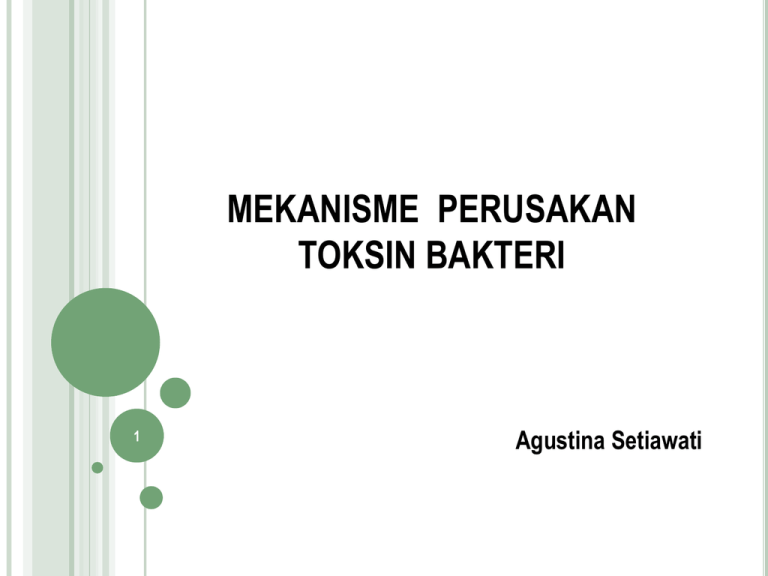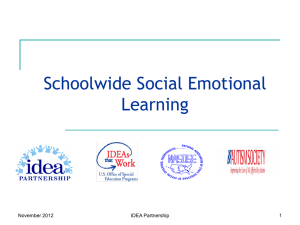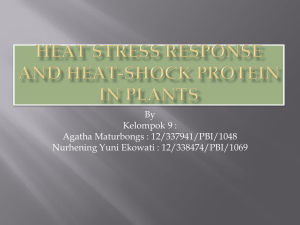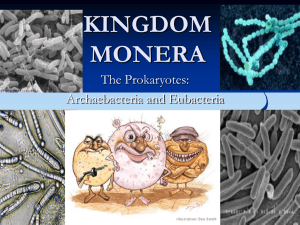MEKANISME PERUSAKAN TOKSIN BAKTERI
advertisement

MEKANISME PERUSAKAN TOKSIN BAKTERI 1 Agustina Setiawati PENDAHULUAN Toksin : substansi terlarut yang dapat mengubah metabolisme normal sel host sehingga kondisi fisiologisnya jg berubah Sel penghasil = bakteri, juga berperan dalam proses yg disebabkan oleh protozoa, cacing dan fungi 2 Toksin mikroba menjadi dibedakan menjadi 2: 1. Eksotoksin 2. Endotoksin 3. Eksoenzim 3 EKSOTOKSIN Protein yg diproduksi oleh bakteri, baik yg diekskresikan atau terikat pada permukaan bakteri dan dilepaskan ketika bakteri lisis. Ditransport ke dalam sel host Mengubah fisiologi dan metabolisme sel host Umumnya terdiri dari sub unit A dan B Contoh eksotoksin: toksin diphteri, kolera dan anthrax EKSOTOKSIN …. Ekstoksin masuk sel host dgn cara: 1) Receptor mediated endocytosis 2) Bergabung dengan lisosom 3) Suasana asam pd lisosom memecah ikatan disulfida dan melepas sub unit A dalam sel 4) Sub unit A berperan dalam berbagai toksisitas intraseluler 5 EKSOTOKSIN …. Mekanisme toksisitas oleh EKSOTOKSIN ada 3: 1. Menghambat sintesis protein : toksin dipteri 2. Hiperaktivitas ekskresi: toksin kolera 3. Penghambatan aktivitas neurotransmitter: toksin tetanus 6 ANTIGENIK EKSOTOKSIN Eksotoksin bersifat antigenik Aktivitas eksotoksin diturunkan oleh antibody dalam tubuh host Eksotoksin tidak stabil, pada suatu saat sifat toksisitasnya hilang tetapi tetap bersifat antigenik Sifat inilah yg dimanfaatkan utk pembuatan TOXOID TOXOID: toksin yg dilemahkan tetapi masih mempunyai sifat antigenik (memacu produksi antibodi). Toxoid digunakan dalam imunisasi 7 CORYNEBACTERIUM DIPHTHERIAE Corynebacterium diptheriae Produces AB exotoxin Gram positive rod w/ tapered ends Significant cause of mortality until 1950s Decline due to vaccination with toxoid (DPT) Spread by close contact via droplets from human carriers or humans with active infection Common location upper respiratory tract Sign and Symptoms Local infection Severe inflammatory reaction Severe swelling in back of neck Sore throat, nausea, vomiting Formation of pseudomembrane Systemic Toxemia as toxin is absorbed from throat and carried by blood to target organs Heart and nervous system MEKANISME AKSI TOKSIN DIPTERI A subunit… Mengaktivitas elongation factor-2) (EF-2) yg diperlukan untuk sintesis protein VIBRIO CHOLERAE Vibrio cholerae Produces A + 5B exotoxin Gram negative vibrio Unusual disease Cholerae does not invade tissue Cholerae does not damage tissue Lives in estuaries on copepods Humans are incidentally infected when ingesting contaminated food or water SYMPTOMS OF VIBRIO CHOLERAE Symptoms Secretory or watery diarrhea No blood in diarrhea Large watery bowel movements Loss of electrolytes Muscle cramps Low blood pressure Rapid heart rate & feeble pulse Vomiting White blood cell count usually normal Treatment Usually self limiting symptoms as long as IV fluids are administered with oral rehydration solutions CLINICAL MANIFESTATIONS www.who.int/entity/water_sanitation_health/dwq/en/admicrob6.pdf TREATING CHOLERA Sack, David, et al. 2004. Seminar: Cholera. The Lancet. 363: 223-233. MEKANISME AKSI TOKSIN KOLERA BACILLUS ANTHRACIS Bacillus anthracis Produces 2A + B exotoxin Gram positive spore forming bacteria Found in soil Anthrax disease – direct exposure to spores Inhalation – pulmonary Ingestion – gastrointestinal Invasion into surface wound – cutaneous No cases involve person to person spread SYGN AND MPTOMS OF BACILLUS ANTHRACIS Cutaneous Spores enter abrasions or cut in skin Germination of spore causes local ulceration of the skin Painless black eschar with edema Antibiotics prevent invasion into blood stream Usually heals completely without scarring SYMPTOMS OF BACILLUS ANTHRACIS Pulmonary Life cycle Macrophages engulf spores Travel to nodes Spores germinate en route Cells are released spreading toxins and vegetative cells into the blood stream Symptoms – caused by toxins Fever and chills Shortness of breath, & cough Massive pleural effusions Sepsis, shock & death MEKANISME AKSI TOKSIN ANTRAK Two primary toxins & capsule gene All three genes are located on plasmids Edema Factor A – toxin Adenylyl cyclase enzyme – increase in cAMP Causes edema and pro-inflammatory response Lethal Factor A – toxin Metalloprotease Cleaves MAP kinase required from cell division and signaling Causes an overall suppression of immune system TRANSDUKSI SINYAL SELULER ADENILAT SIKLASE-CAMP 20 MEKANISME AKSI TOKSIN ANTRAK EF LF EDEMA Increased expression of pro-inflammatory mediators B cAMP EF Endosome B MAPK IMMUNE SUPPRESSION WBCs do not divide in the presence of pathogens; overall decrease in phagocytosis Acidic Environment CLOSTRIDIUM TETANUS Clostridium tetanus Produces AB exotoxin Produces irreversible muscle contraction Spastic paralysis Symptoms result entirely from toxin Anaerobic gram + spore forming rod Lives in soil usually on rusty metal Enters from puncture wound or cut Organism does not spread form entry point Begins with stiff back and neck muscles Death results from respiratory failure MEKANISME AKSI TOKSIN TETANUS Menghambat pelepasan ‘inhibitory neurotransmitter ‘ yaitu GABA – aminobutyric acid γ 24 ENDOTOKSIN Endotoksin Nama sering menyebabkan salah arti Toksin tidak berada dalam sel bakteri, tetapi bagian membran sel bakteri Toksin terletak pada bagian luar membran sel bakteri Lipopolisakarida (LPS)bakteri gram Asam lipotekoat bakteri gram + Toksik pada konsentrasi yg tinggi Dapat dilepaskan oleh bakteri saat lisis, spt: E.coli, Salmonella, Shigella, Pseudomonas, Haemophilus Menurunkan sistem imun host Mempunyai efek farmakologis yg berbeda pada konsentrasi rendah atau tinggi 26 MECHANISM OF ACTION OF ENDOTOXINS Endotoxins bind to Receptors on Macrophages Neutrophils Lymphocytes Proteins of complement Complement is a group of proteins which circulate at constant levels in the blood When activated complement is a powerful tool against invading pathogens Increased inflamation, opsonization, & MAC Endotoksin Host cell receptors (TLR) bind to endotoxin TLR (Toll-like Receptor) Inflammation Opsonization MAC PIROGEN Merupakan salah satu endotoksin, ada yg menyebutkan ENDOTOKSIN=PIROGEN Bagian Lipid A membran bakteri gram – Potensi lebih rendah dibandingkan eksotoksin Aksi tidak spesifik Stabil terhadap pemanasan selama 30’, Tidak bersifat antigenik (tidak bisa diubah menjadi toksoid) 30 MEMBRAN SEL BAKTERI 31 32 LIPOPOLISAKARIDA Bagian paling luar membran sel Total 3- 10% berat kering sel 3-4 juta molekul tiap sel Bagian yg disebut pirogen: Lipid A Lipid A menstimulasi sistem imun manusia 33 MEKANISME AKSI PIROGEN LPS terikat pada protein plasma LPS binding protein (LBP) LBP berikatan dgn reseptorpd makrofag dan monosit sehingga menyebabkan: 1. Produksi sitokin (IL, TNF) memicu produksi prostglandin & leukotrien inflamasi 2. Aktivasi komplemen pelepasan histamin yg menyebabkan vasodilatasi 3. Koagulasi 34 35 36 TES PIROGEN Rabbit Pyrogen Test Limulus Amoebocyte Lisate Test 37 BACTERIAL EXOENZYMES Enzim yg dieksresikan bakteri pada matriks ekstraseluler sel, mempunyai berbagai aktivitas: Merusak membran Merusak membran sell host Lisis sel eritrosit Merusak matriks ekstraseluler (fibronectin, kolagen & MMP) Mengubah aktivitas obat co: Penisilanase (hidrolisis penisilin) EKSOENZIM α toxin Pore forming toxin Common in Staphylococcus aureus Destroy red blood cells Streptolysins – group of hemolysins excreted by Streptococcus Streptokinase Attacks fibrin clots From Streptococcus pyogenes Hyaluronidase Hemolysins Breaks down hyaluronic acids in connective tissue Similar function for Collagenase Elastases DNase DNA is viscous Thins pus (DNA & debris) released from WBC CLOSTRIDIUM PERFRINGENS Clostridium perfringens Ananerobic gram + spore forming rod Widely distributed in nature Myonecrosis Entry of spores by traumatic injury Not highly invasive so it requires exoenzymes for a supportive growth environment Exoenzymes Lecithinase lipase c – major toxin Lyses mammalian cells indiscriminately Substrate is phophatidylcholine Collagenase & hyaluronidase DNAase 41 42











